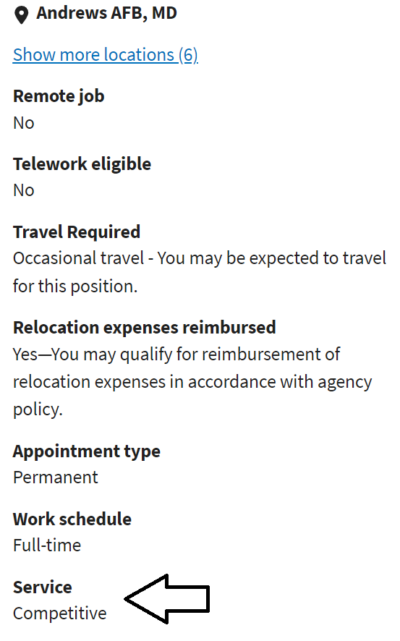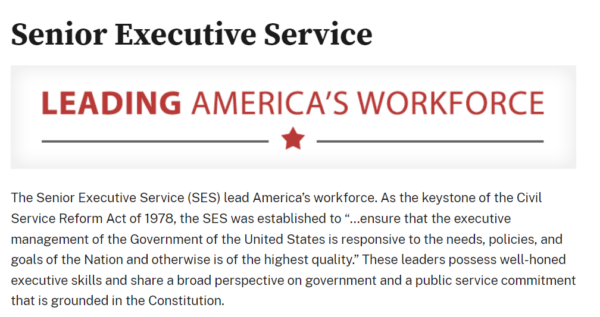Service Types for Federal Employment

The following post takes a closer look at the different Service Types for Federal Employment.
Before you start searching and applying to federal jobs – it’s important to know that the U.S. federal government categorizes all civilian federal jobs under one of three different ‘service types’.
Related: Transitioning from Private Sector to Federal Employment
Each service type comes with its own application processes and requirements. So, knowing which one applies to your target position is key to navigating the federal job market effectively.
Here’s what you need to know.
Overview
The three service types are: Competitive Service, Excepted Service, and Senior Executive Service. Each service type features its own distinct rules and processes for hiring.
So, where can you find the service type for a job?
On the righthand side of every job listing on USAJOBS you’ll find a category called ‘service’. In the sample job description below, we see the posting is labeled as competitive service.

Pictured: Sidebar of a sample USAJOBS posting showing competitive service.
Competitive Service
The majority of listings on USAJOBS are Competitive Service.
Simply put, Competitive Service positions are subject to the civil service laws passed by Congress (most notably Title 5) ensuring fair and equal treatment in the hiring process. As such, all applicants for Competitive Service jobs go through a formal evaluation and hiring process that is open to everyone.
The Competitive Service process includes:
- Written tests
- Evaluations of education and experience
- Assessments of other necessary skills and attributes
Excepted Service
Excepted Service positions are the least common service type.
Excepted Service roles are not bound by the same rules as Competitive Service and can be filled using a variety of specialized appointment methods that offer more flexible hiring processes.
Examples include:
- VRA: Allows agencies to hire eligible veterans without competition (Veterans’ Recruitment Appointment).
- Pathways Participants: Includes internships and full-time positions for recent graduates.
- Attorney Positions: Certain legal positions are categorized as excepted due to specialized qualifications.
- Schedule A: Used for hiring individuals with disabilities.
Senior Executive Service
Senior Executive Service (SES) are for senior management roles at the highest levels of government.
SES positions are typically filled through a non-competitive evaluation and selection process. Likewise, SES positions are often appointed by the President or other senior officials, involving a rigorous vetting process.
Although SES positions are technically ‘non-competitive’ – in the sense that they are not open to everyone – SES roles are indeed among the most competitive and sought-after positions within the federal government.

Pictured: Screenshot from OPM.gov on SES.
Many SES positions require applicants to submit Executive Core Qualifications (ECQs) demonstrating their expertise in key leadership areas including leading people, managing results, and building coalitions.
In Conclusion
In conclusion, I hope this overview helps with understanding the different service types for federal employment. Before applying, it’s wise to check the job announcement and verify the service type listed to ensure it aligns with your career goals and qualifications.








